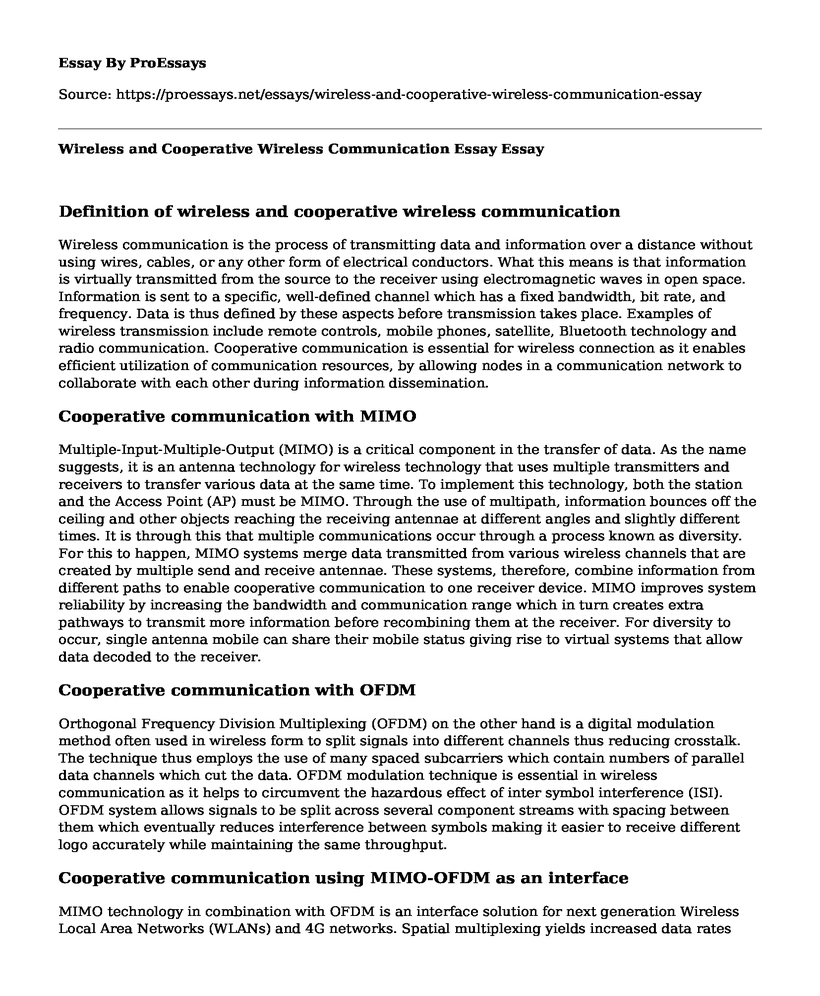Definition of wireless and cooperative wireless communication
Wireless communication is the process of transmitting data and information over a distance without using wires, cables, or any other form of electrical conductors. What this means is that information is virtually transmitted from the source to the receiver using electromagnetic waves in open space. Information is sent to a specific, well-defined channel which has a fixed bandwidth, bit rate, and frequency. Data is thus defined by these aspects before transmission takes place. Examples of wireless transmission include remote controls, mobile phones, satellite, Bluetooth technology and radio communication. Cooperative communication is essential for wireless connection as it enables efficient utilization of communication resources, by allowing nodes in a communication network to collaborate with each other during information dissemination.
Cooperative communication with MIMO
Multiple-Input-Multiple-Output (MIMO) is a critical component in the transfer of data. As the name suggests, it is an antenna technology for wireless technology that uses multiple transmitters and receivers to transfer various data at the same time. To implement this technology, both the station and the Access Point (AP) must be MIMO. Through the use of multipath, information bounces off the ceiling and other objects reaching the receiving antennae at different angles and slightly different times. It is through this that multiple communications occur through a process known as diversity. For this to happen, MIMO systems merge data transmitted from various wireless channels that are created by multiple send and receive antennae. These systems, therefore, combine information from different paths to enable cooperative communication to one receiver device. MIMO improves system reliability by increasing the bandwidth and communication range which in turn creates extra pathways to transmit more information before recombining them at the receiver. For diversity to occur, single antenna mobile can share their mobile status giving rise to virtual systems that allow data decoded to the receiver.
Cooperative communication with OFDM
Orthogonal Frequency Division Multiplexing (OFDM) on the other hand is a digital modulation method often used in wireless form to split signals into different channels thus reducing crosstalk. The technique thus employs the use of many spaced subcarriers which contain numbers of parallel data channels which cut the data. OFDM modulation technique is essential in wireless communication as it helps to circumvent the hazardous effect of inter symbol interference (ISI). OFDM system allows signals to be split across several component streams with spacing between them which eventually reduces interference between symbols making it easier to receive different logo accurately while maintaining the same throughput.
Cooperative communication using MIMO-OFDM as an interface
MIMO technology in combination with OFDM is an interface solution for next generation Wireless Local Area Networks (WLANs) and 4G networks. Spatial multiplexing yields increased data rates received in wireless communication links which can cause fading. A MIMO-OFDM based system, therefore, allows spatial multiplexing to be done by transmitting independent data with total transmitting power split across antennas and tones which in turn reduces this effect.
Secondly, space-frequency coding aims to introduce redundancy across space and time for spatial diversity in MIMO systems to be realized. In many situations, obtaining channel estimation can be difficult, it is thus essential to develop coding schemes that do not require channel estimates at the transmitter or receiver. The MIMO-OFDM system is vital in the modulation and demodulation systems mainly through codes developed.
Lastly, multiple-access in MIMO-OFDM systems is achieved through cooperative communication. In OFDM systems where collision is high, allows for simple multiple access using a single antenna. Signals are thus assigned different subsets of the available OFDM tones to users. The resulting multi-access orthogonal frequency division multiple access (OFDMA) is thus derived from a combination of orthogonal frequency division multiplexing (OFDM) and frequency division multiple access (FDMA). OFDMA combined with MIMO eventually augments performance and boost capacity and range.
Introduction
In conclusion, it is clear that cooperative communication is essential and can be achieved through the use of both MIMO and OFDM systems. These systems can thus act as air interface in ensuring that wireless connection occurs efficiently. MIMO-OFDM systems can, therefore, help in guaranteeing multiple-access to broadcasting channels and in the creation of the next generation networks.
Cite this page
Wireless and Cooperative Wireless Communication Essay. (2022, Apr 14). Retrieved from https://proessays.net/essays/wireless-and-cooperative-wireless-communication-essay
If you are the original author of this essay and no longer wish to have it published on the ProEssays website, please click below to request its removal:
- iPhone vs. Android Report
- Paper Example on Change: Problems with Privacy Policy on Facebook
- Should the Use Of Drones Be Banned? Essay Example
- Ethical Issues Related To Nuclear Energy - Essay Sample
- Essay Example on Cloud Computing: Front-End & Back-End Explained
- Essay Example on Leveraging Global Markets with Tech & Virtual Health: Healthcare Evolves
- Essay Example on Securing Digital Data: Cybersecurity Strategies and Tactics







